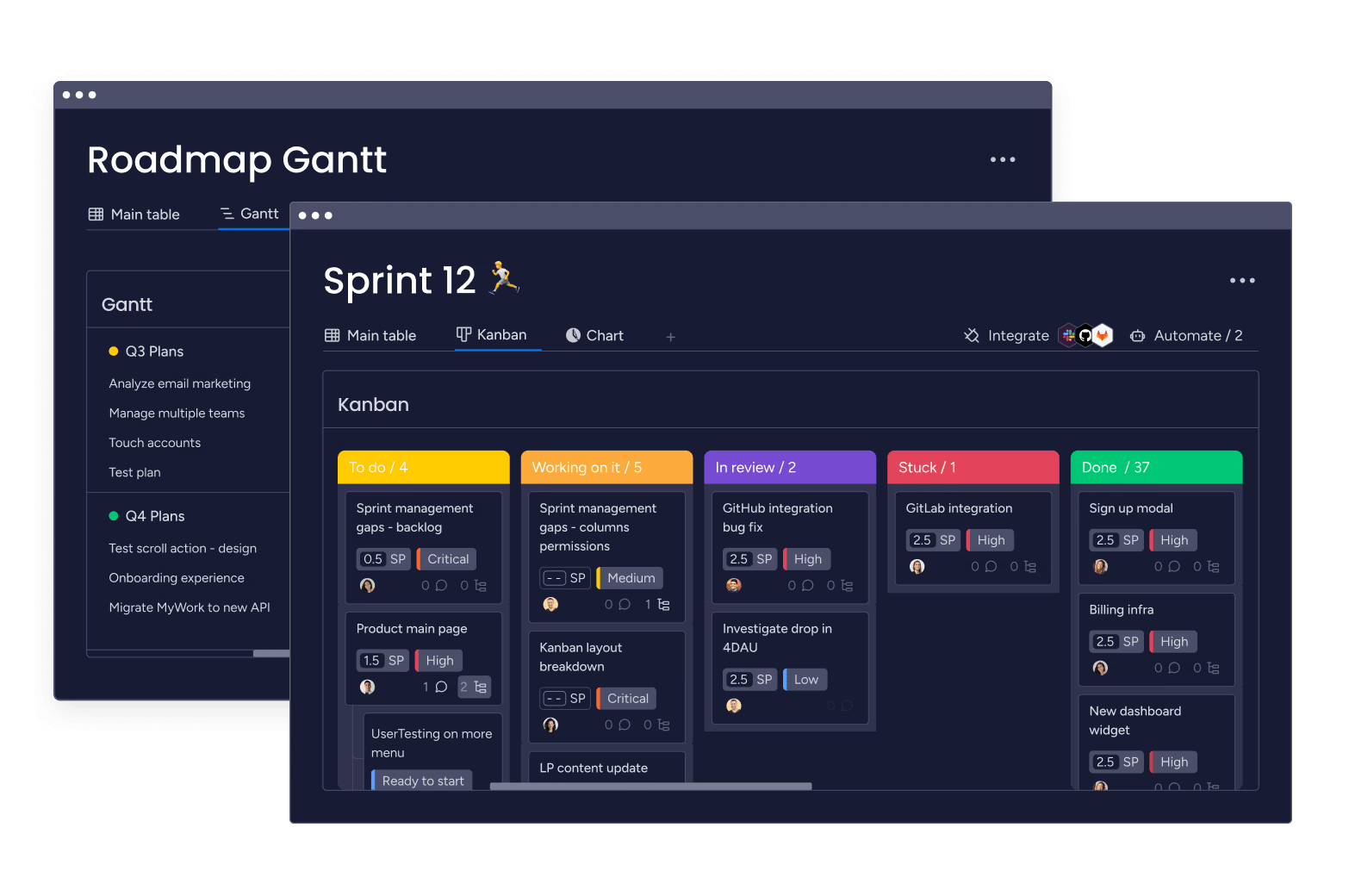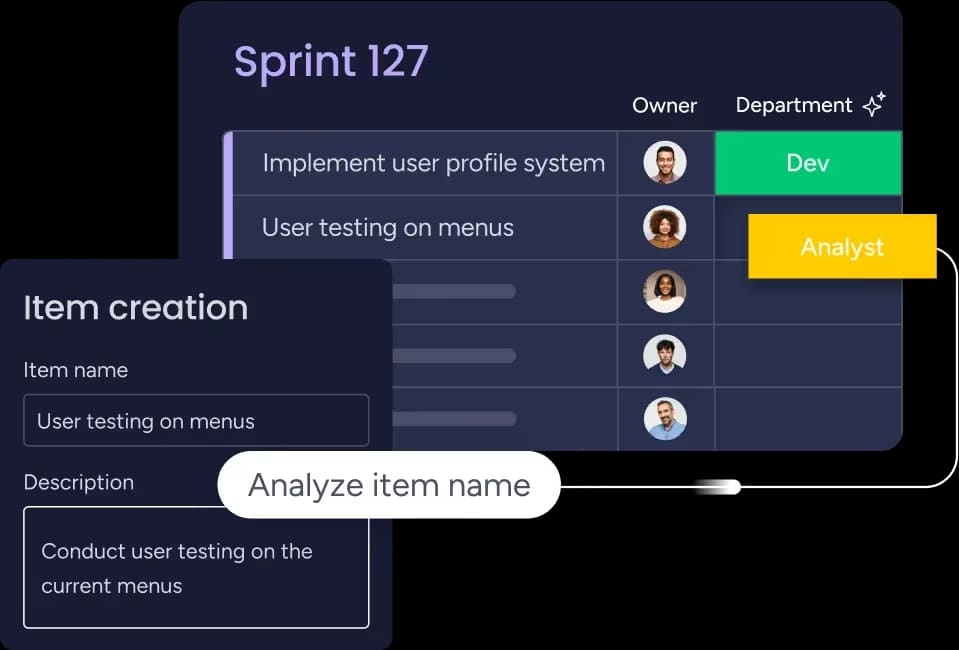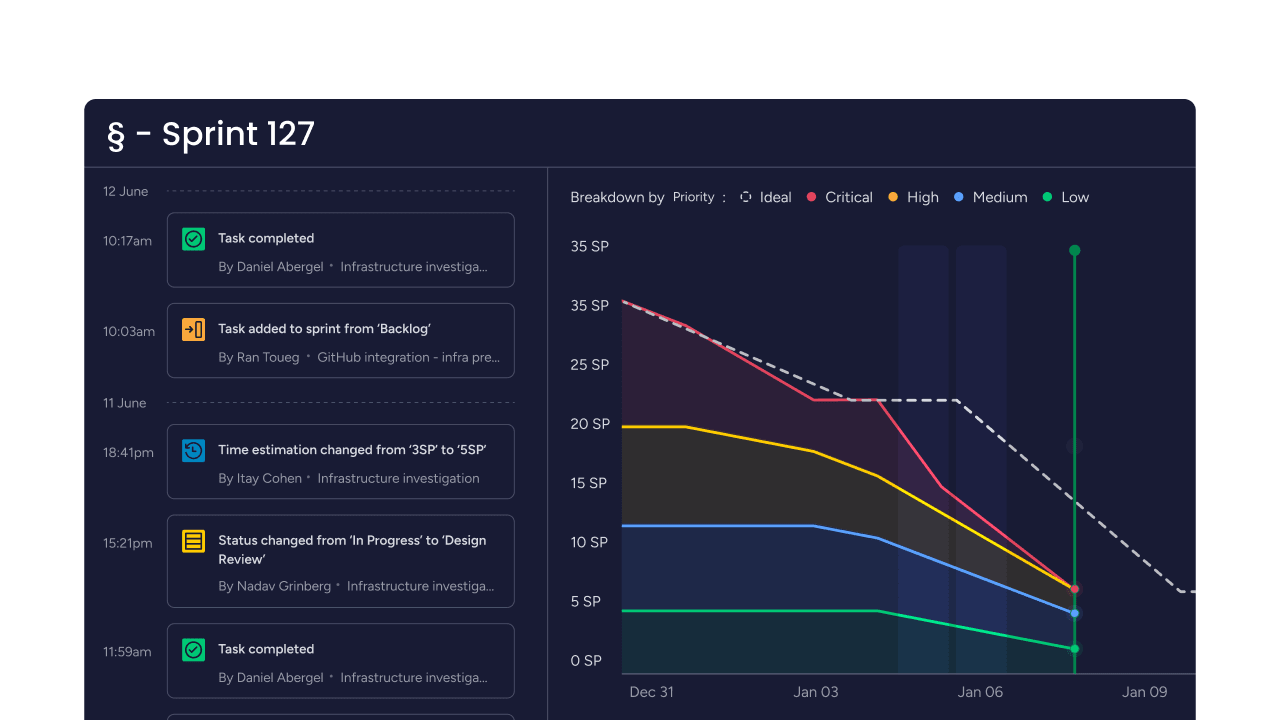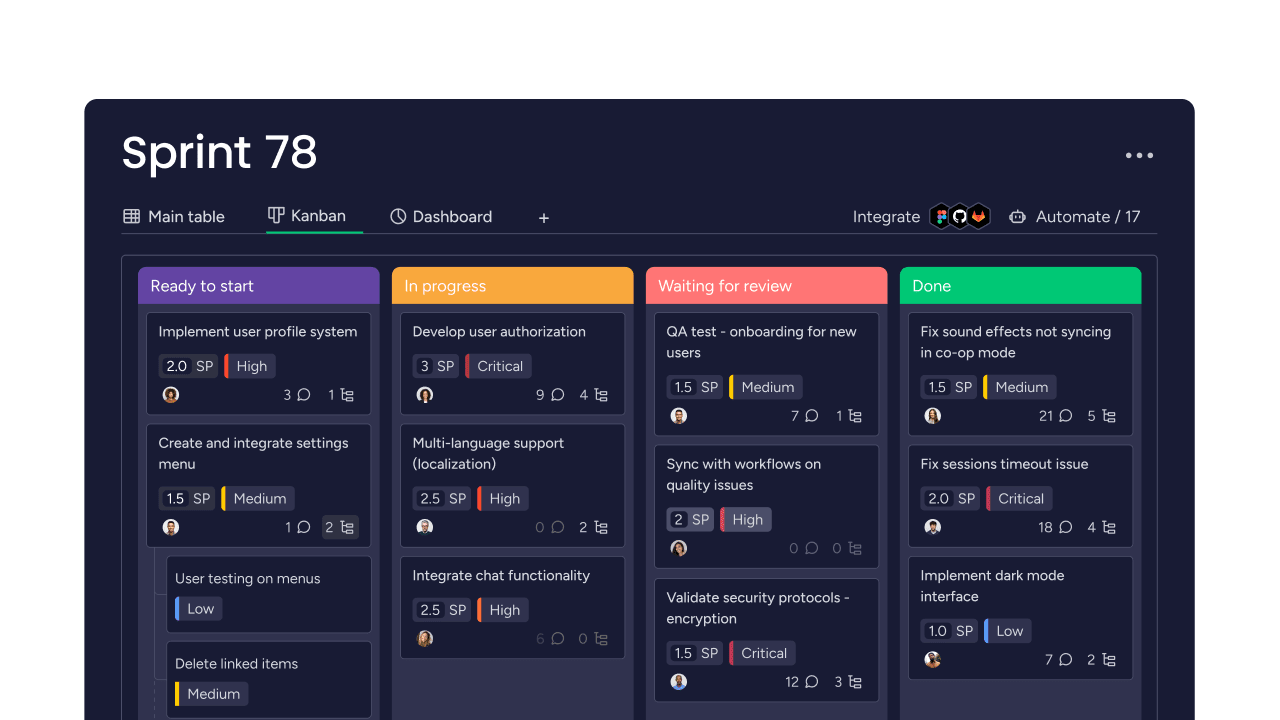Development teams face a constant challenge: turning a long-range product vision into focused, predictable work. Without a clear plan for the immediate future, teams can get lost in shifting priorities, leading to missed deadlines and stakeholder frustration. The sprint backlog provides the structure to solve this.
This guide explains how to create and manage an effective sprint backlog. We will cover its core components, its role in the Scrum framework, and the key differences between it and the product backlog. You will also learn a 5-step process for building your backlog and best practices for keeping your sprints on track.
Try monday devKey takeaways
- A sprint backlog is your team’s focused to-do list for 1-4 weeks, containing selected work items, a clear sprint goal, and your delivery plan.
- Create effective sprint backlogs by preparing beforehand, selecting realistic work based on team capacity, and breaking items into daily tasks.
- Keep your sprint goal visible and reference it daily to maintain focus and avoid scope creep that derails your sprint commitments.
- Update your sprint backlog daily during standups, but only add new work if it supports your sprint goal and your team has available capacity.
- Streamline sprint management with monday dev’s AI-powered planning, real-time visibility across teams, and flexible workflows that adapt to your process.
What is a sprint backlog?
A sprint backlog is a prioritized list of tasks or user stories that a Scrum team commits to completing during a single sprint, typically lasting 1 to 4 weeks. It’s created during sprint planning, when items are selected from the broader product backlog and broken down into actionable work.
Think of it as the team’s focused to-do list for the current sprint — while the product backlog covers everything that could be built, the sprint backlog contains only what the team will build right now.
Definition and core components
Every sprint backlog contains 3 essential parts that guide your team’s work:
- Select product backlog items: The specific features, user stories, or bugs you’ve chosen to work on
- Sprint goal: A short statement explaining why this sprint matters
- Plan for delivery: How you’ll turn these items into working software
Sprint backlog within the Scrum framework
The sprint backlog is 1 of 3 main Scrum artifacts, alongside the product backlog and increment. It connects your long-term product vision to daily development work.
You create the sprint backlog during sprint planning. Then you reference it in daily Scrum meetings to coordinate work and spot problems early. The sprint backlog stays visible throughout the sprint, helping everyone understand what’s happening and what needs attention.
Who owns the sprint backlog?
The development team owns the sprint backlog. This means developers can add tasks, remove unnecessary work, or adjust estimates as they learn more during the sprint.
The product owner manages the product backlog but can’t change the sprint backlog once the sprint starts. This separation protects the team from disruptions while keeping them accountable for their commitments.
Sprint backlog vs. product backlog

Understanding how these 2 backlogs work together helps you plan and execute sprints more effectively. While they both contain work items, they serve different purposes in your development process.
Key differences to know
| Aspect | Sprint backlog | Product backlog |
|---|---|---|
| Purpose | Plan for the current sprint | Capture all potential work for the product |
| Timeframe | 1–4 weeks | Entire product lifecycle |
| Owner | Development team | Product owner |
| Content | Selected items, sprint goal, tasks | Features, bugs, ideas, improvements |
| Updates | Adjusted daily during the sprint | Continuously refined and reprioritized |
| When to use | During sprint execution — guides daily standups and short-term progress | For long-term planning and stakeholder discussions — helps prioritize future work based on business value |
How both backlogs work together
Items flow from product backlog to sprint backlog during sprint planning. The product owner ensures items are ready, then the team selects what they can complete.
After each sprint, completed work provides insights that help prioritize the product backlog. This creates a feedback loop where execution informs planning.
Pro tip: AI-powered work platforms like monday dev can help automate this flow — from pulling ready items into sprint backlogs to tracking progress and updating priorities in real time.
Benefits of using a sprint backlog
Sprint backlogs transform chaotic development into predictable delivery cycles. They give teams structure without sacrificing the flexibility that makes Agile work.
Drive team focus and alignment
A sprint backlog eliminates confusion about priorities. When everyone knows exactly what needs to be done this sprint, they can make confident decisions about their daily work.
This focus prevents scope creep too. When someone asks for “just one more feature,” you can point to the sprint backlog and explain why new work must wait.
Enable predictable delivery
Sprint backlogs create accountability through explicit commitments. Stakeholders know what to expect at the end of each sprint, which builds trust across the organization.
Teams develop Scrum metrics by tracking completed work over multiple sprints. This data helps you make realistic commitments and avoid the disappointment of missed deadlines, which is critical given that employees who understand how success is measured are 2x more likely to feel motivated.
Support Agile flexibility
While sprint backlogs represent commitments, they’re not set in stone. Teams can adjust their work when they discover new information—as long as changes support the sprint goal.
Try monday devWhen is a sprint backlog created?
Sprint backlogs come to life during sprint planning meetings at the start of each sprint. This ceremony brings together the product owner, Scrum master, and development team to select work and create their plan.
Most teams schedule sprint planning right after finishing their previous sprint. Some combine it with sprint reviews and retrospectives to create a smooth transition between iterations.
Before planning starts, make sure your product backlog items are refined and ready. After planning ends, the team begins executing while the product owner prepares items for future sprints.
What goes into a sprint backlog?
A complete sprint backlog contains several types of work that support your sprint goal. Understanding what belongs helps you create balanced sprints that deliver real value. Here’s a list to get you started:
Selected product backlog items
Teams choose items based on priority, capacity, and dependencies. Your selections should represent the most valuable work you can realistically finish within the sprint. Common item types include:
- User stories: Features that deliver customer value
- Bug fixes: Issues affecting product quality
- Technical debt: Work that maintains system health
Each item needs clear acceptance criteria and should be small enough to complete within the sprint. monday dev’s AI-powered categorization can help organize these items automatically, suggesting appropriate categories and owners based on patterns in your data.
Sprint goal
Your sprint goal provides purpose and direction for all the work in your backlog. Good sprint goals are specific but flexible.
Strong sprint goal examples:
- Enable password reset via email
- Reduce checkout abandonment by fixing top 3 user pain points
- Improve API response time to under 200ms
Weak sprint goals are too vague (“improve the product”) or too narrow (“fix bug #1234”). The best goals inspire teams while connecting to business outcomes.
Task breakdowns and time estimates
Teams break product backlog items into specific work items that take a day or less to complete. This granularity helps track daily progress and coordinate work. Task examples might include:
- Design login page mockup
- Write API endpoint for password reset
- Create unit tests for authentication
- Update user documentation
Estimate each task in hours rather than story points. These estimates help identify capacity issues before they impact delivery.
Action items from previous retrospectives
Don’t forget process improvements from your Agile retrospectives. These items deserve space in your sprint backlog alongside feature work.
- Reduce code review time to under 4 hours
- Automate deployment process
- Document API standards
With a clear understanding of what belongs in your sprint backlog, you’re ready to build one that drives real results.
How to create a sprint backlog in 5 steps

Creating an effective sprint backlog requires a systematic approach that balances ambition with realism. The following 5-step process will guide you through building a sprint backlog that sets your team up for success:
Step 1: Prepare for sprint planning
Review your product backlog to ensure items are refined, estimated, and prioritized. As a best practice, development teams should spend no more than 10% of their capacity on these backlog grooming activities.
Step 2: Select your product backlog items
Start with the highest-priority items and work down until you reach capacity. Consider complexity, risk, and dependencies when making selections.
Balance challenging work with routine tasks. Leave some buffer capacity for unexpected issues — most teams find 70-80% allocation works well.
Step 3: Define a clear sprint goal
Create a sprint goal that connects your selected items to business value. Involve the whole team to ensure everyone understands and supports the goal.
Write your goal as a single sentence that explains what you’ll achieve and why it matters. Post it prominently so everyone remembers it throughout the sprint.
Step 4: Break down work into manageable tasks

Decompose each product backlog item into specific tasks. Aim for work items that 1 person can complete in a day or less.
Identify dependencies between tasks and any external blockers. Address these proactively rather than hoping they’ll resolve themselves.
Step 5: Estimate and commit to your sprint
Review your total effort against available capacity. Remember that meetings, code reviews, and interruptions typically consume 20-30% of available time.
Make final scope adjustments if needed. Then get explicit commitment from the team before ending the planning session.
Try monday dev7 best practices for managing sprint backlogs
Creating a sprint backlog is just the beginning. The real challenge lies in managing it effectively throughout the sprint to ensure your team delivers on its commitments. These 7 best practices will help you maintain focus, adapt to changes, and build a sustainable rhythm that improves with each iteration.
1. Keep the sprint goal front and center
Reference your sprint goal during every daily standup. When someone suggests new work, ask: “Does this support our sprint goal?”
2. Make your sprint backlog visible to everyone
Transparency builds trust and enables better collaboration, a crucial benefit in environments where only 61% of employees in large enterprises report being satisfied with organizational transparency, according to The world of work report. Use digital boards or physical walls to display your sprint backlog where everyone can see it.
Pro tip: For real-time visibility through customizable dashboards, monday dev ensures team members see current priorities, spot bottlenecks, and coordinate efforts without constant meetings.
3. Handle mid-sprint changes wisely
Sometimes change is necessary. Accept new work only when:
- It supports the sprint goal
- The team has capacity
- Everyone agrees to the change
Document scope changes and communicate them to stakeholders immediately.
4. Track progress without micromanaging

Monitor trends rather than individual performance by using burndown charts or completion percentages to spot problems early. Give team members autonomy while maintaining visibility into sprint health. Intervene only when you see systemic issues.
5. Review daily but adapt thoughtfully
Update your sprint backlog during daily standups. Move completed items to done, add newly discovered tasks, and flag blockers. Make substantial changes only when they improve your chances of meeting the sprint goal.
6. Balance team capacity realistically
Most teams overestimate their available time. Account for:
- Regular meetings (15-20% of time)
- Code reviews and testing
- Context switching between tasks
- Unexpected questions and issues
Plan conservatively to improve delivery predictability.
7. Learn from each sprint
Track what you planned versus what you delivered. Look for patterns in estimation accuracy, scope changes, and blockers.
Use these insights to improve future planning. Small improvements compound over time into major gains.
Common sprint backlog challenges and solutions
Even well-intentioned teams encounter obstacles that can derail sprint execution. Recognizing the following common challenges and implementing proven solutions helps you maintain momentum and deliver consistently.
Challenge: Managing overcommitment and realistic planning
Teams often plan optimistically, leading to incomplete sprints. This pattern destroys trust and morale over time.
Solution: Track your velocity across multiple sprints. Use this data to plan realistically rather than hopefully. When you do overcommit, focus on completing the most valuable items first.
Challenge: Addressing unclear requirements
Vague product backlog items waste time during sprints. Teams build the wrong thing or spend hours seeking clarification.
Solution: Create a definition of ready that items must meet before entering a sprint. Include criteria like:
- Clear acceptance criteria
- Estimated effort
- No unresolved questions
Defer items that don’t meet these standards.
Challenge: Managing cross-team dependencies
Dependencies on other teams can block your progress. These are especially challenging in large organizations.
Solution: Identify dependencies during planning. Coordinate delivery dates before the sprint starts. Track dependencies visually and escalate issues early when external work falls behind.
Challenge: Handling incomplete sprint items
When items remain unfinished, decide whether to carry them forward or return them to the product backlog.
Solution: Carry forward items that are nearly complete and support the next sprint goal. Return everything else for re-prioritization. Use incomplete items to improve future estimation.
Understanding sprint backlog platforms and software
Managing sprint backlogs manually through spreadsheets or physical boards becomes impractical as teams grow. Sprint backlog platforms streamline planning, tracking, and collaboration while providing the visibility teams need to deliver consistently.
Let’s look at the essential features to look for, compares popular platforms, and helps you choose the right solution for your team’s needs.
Essential spring backlog software features
Effective sprint backlog platforms provide comprehensive support for Agile workflow. Key features to evaluate include:
- Sprint planning support: Drag-and-drop selection, capacity visualization, velocity tracking
- Task breakdown: Hierarchical organization, time estimates, dependency mapping
- Progress tracking: Burndown charts, completion metrics, sprint health indicators
- Team collaboration: Comments, mentions, real-time updates, integration with chat platforms
Popular sprint backlog management platforms
Several platforms support sprint backlog management, each with distinct strengths. Here are a few of the top sprint backlog management platforms availble:
- Jira offers extensive customization for complex workflows. Its robust reporting appeals to large teams, though the learning curve can be steep.
- Azure DevOps integrates backlog management with code repositories and pipelines. It excels in Microsoft-centric environments.
- Asana provides user-friendly task management with Agile support. Its simplicity makes it accessible to non-technical team members.
- monday dev combines flexibility with powerful automation and AI features. Teams can adapt it to various Agile approaches while maintaining structure.
Choosing the right platform for your team
When choosing the right platform, consider your team size, technical needs, and budget when selecting a platform. Evaluate ease of use and onboarding support because teams usually adopt simple platforms faster.
Think about long-term scalability and integration needs. Choose solutions that can grow with your team and connect to your existing platforms.
Streamline sprint backlog management with monday dev

monday dev transforms sprint backlog management through intelligent automation and flexible workflows. Built on the monday.com Work OS, it adapts to how your team actually works.
Flexible workflows that match your process
Create sprint boards that reflect your unique process. Whether you follow strict Scrum or a hybrid approach, monday dev adapts to your needs with customizable templates and sprint planning views.
Customize fields, statuses, and views without forcing your team into rigid patterns. Use dynamic status columns to visualize work progress and automations to update stakeholders when items move through your workflow. This flexibility helps teams maintain their preferred workflows while gaining structure and visibility.
Real-time visibility across teams
Bridge the gap between engineering and business with transparent sprint tracking. Stakeholders see progress without disrupting development work through shareable dashboards and configurable permissions.
Automated dashboards keep everyone aligned on sprint goals and potential risks. Create sprint burndown widgets that update in real-time and velocity trackers that measure team performance across sprints. This visibility enables proactive decisions and reduces status meeting overhead.
AI-powered sprint planning

Use AI blocks to categorize work automatically, suggest task assignments, and identify potential bottlenecks. Leverage monday dev’s AI Assistant to draft user stories, generate acceptance criteria, and estimate complexity based on historical data. These intelligent features reduce planning overhead and improve accuracy.
Historical data analysis helps predict realistic capacity and highlight risks before they impact delivery. monday dev’s sprint insights feature automatically calculates team velocity and suggests optimal sprint loads. Teams make smarter decisions with Agile planning and less effort.
Seamless integration with your tech stack
Connect monday dev to your development tools for a unified workflow. With 2-way integrations with GitHub, GitLab, Slack, Jira, and other platforms, you can eliminate context switching. Use the code commit tracker to link code changes directly to sprint items and automate status updates when pull requests are merged.
Keep sprint backlogs synchronized with code repositories and communication channels. Set up automations that trigger notifications in Slack when a blocker appears or create GitHub issues directly from your sprint backlog. This connectivity ensures everyone works from the same information while maintaining your existing development practices.
Build focus and predictability with smarter sprint backlogs
A well-managed sprint backlog turns Agile principles into real results — helping teams stay focused, deliver predictably, and continuously improve. By combining disciplined planning with the flexibility to adapt, you can make every sprint more effective than the last.
With monday dev, you can take it a step further by automating backlog updates, tracking progress in real time, and using AI insights to plan smarter and move faster toward your goals.
Try monday devFAQs
How many items should be in a sprint backlog?
The number of items in a sprint backlog depends on your team's capacity and the complexity of the work. Most teams handle 3-10 product backlog items in a 2-week sprint, though this varies based on item size and team experience.
Can you add new items to the sprint backlog during a sprint?
You can add items to the sprint backlog if they support the sprint goal and your team has capacity after completing committed work. Always discuss additions with the entire team and document the scope change for transparency.
What happens to incomplete sprint backlog items?
Incomplete sprint backlog items typically return to the product backlog for re-prioritization. Teams may carry over nearly complete items that align with the next sprint's goals, but this should be the exception rather than the rule.
How do you estimate effort for sprint backlog tasks?
Teams estimate sprint backlog tasks in hours using techniques like planning poker or group discussion. Keep estimates simple. Most tasks should take 4-8 hours, making daily progress visible and predictable.
Should every team member have assigned tasks in the sprint backlog?
While tasks often have individual assignees for accountability, the entire team shares responsibility for completing the sprint backlog. Balance individual ownership with collective commitment to sprint success.
How often should teams update their sprint backlog?
Teams should update their sprint backlog daily during standup meetings. Regular updates keep the backlog accurate and help identify issues before they become critical problems.

